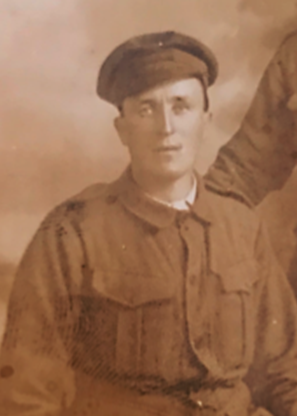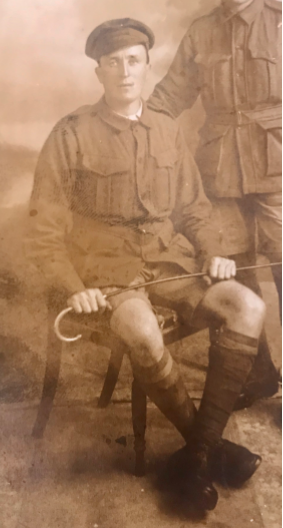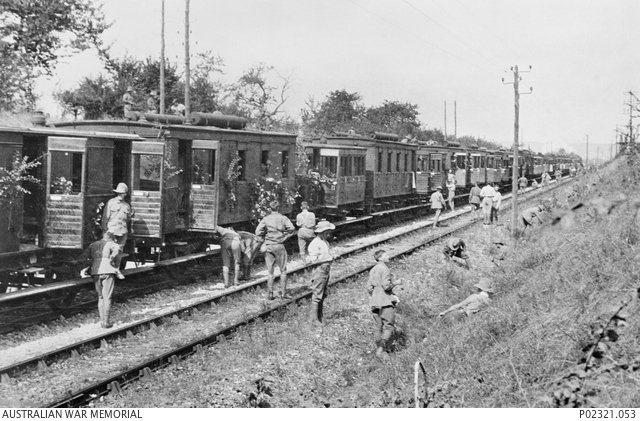
Cairo, Egypt - 31 March 1916
Henry Steven BRANDON
Eyes blue, Hair fair, Complexion fair
One of the casualties at Fromelles 1916 – Forget me not
We acknowledge Gary Brandon who wrote the story of his grandfather’s involvement at Fromelles. In turn, Gary acknowledges the many books written about the Western Front and about Fromelles that aided his research and makes special mention of Ross St.Claire’s book, Our Gift to the Empire - 54th Infantry Battalion 1916 - 1919 ISBN 0-6464589-7-3 . He also extends his thanks to Royce Atkinson of the Fromelles Association of Australia for this opportunity to tell one man’s story of the 5533 casualties of an awful day in Australia’s Military past. For family wishing to make contact, Gary can be contacted through the Fromelles Association of Australia.

Private Henry Steven Brandon 4444 – known as Zacher - was born in Sydney, New South Wales, in February 1890. Zacher's father, Patrick, died when he was relatively young and, as the eldest son, he took on the responsibility of a family consisting of his mother, Matilda, two brothers and three sisters.
He was a single twenty-five-year-old pipe maker, still living at the family home when he enlisted at Liverpool New South Wales on 3 August 1915. Decades later, his son, Leslie, observed that his father was a royalist and that signing up to World War 1 was his duty to the King and that England was very much our motherland.
Following his basic training, he was assigned to the 14th Reinforcements, 13th Battalion which embarked from Sydney on HMAT Ballarat for Egypt on 22nd March 1916.
Arriving in Egypt after the evacuation from Gallipoli, Private Brandon was part of the expansion of the AIF from two to five Divisions. Like many soldiers, he had his photo taken in Cairo whilst on leave. This photo was sent home as a postcard and it ends simply with, ‘From Zacher with best wishes, forget me not’.
In early April, Zacher was assigned to the 54th Battalion at Ferry Post, Egypt near the Suez Canal. Defending the canal from the Turks and training were the priorities for this new battalion.
Heading for France and the Western Front
On 16 June 1916, the 54th Battalion marched out of Ferry Post for Moascar, Egypt and then entrained to Alexandria in order to board the HMAT Caledonian on 19 June 1916. They anchored in Marsa Sericca Bay, Malta on 25 June but the men were not allowed off the ship. After two days at Malta their journey continued across the Mediterranean Sea arriving in Marseilles, France on 29 June 1916.
Memories of arriving in France
Zacher’s grandson recalls his Pop Brandon’s description of arriving in France:
`"He described the excitement of arriving in Marseilles and travelling by troop train through the beautiful summer filled countryside. He recalled being cheered by the French people, predominately females, in the towns or working in the fields beside the tracks."`
Troops remained on the ship overnight with again no leave granted; they were entrained for an ‘unknown destination’ early the next morning. The trains departed at 10:45am with some soldiers hoping that their next destination would be Paris. These hopes were dashed as the troop trains only circled that city en route directly to Flanders in northern France.

A Timeline for the 54th Battalion- July 1916
2 July 1916, 10pm After a two-and-a-half-day journey, they detrained at Thinness, France about ten kilometres from the important rail junction of Hazebrouck. The battalion was billeted locally. Officers slept inside the farmhouses, seniority dictating if they slept in a bed or on the floor, while soldiers like Zacher made do the best they could by occupying the barns and other outbuildings. Next morning most men probably wandered around their strange new surroundings, noticing the war damaged buildings.
At night, the local entertainment was found at the estaminet where cheap champagne, beer and wine could be bought in addition to cooked meals of eggs, chips and chicken. After the endless sands of Egypt just lying on the grass was a welcomed change for many. Training recommenced almost immediately, particularly aimed at bringing the new recruits like Zacher up to the standard of the Gallipoli veterans.
8 July 1916 The battalion marched to Morbecque where they were issued with helmets and gas marks and also underwent some extensive gas training.
9 July 1916 8am Led by their drum band, the 54th Battalion marched to new billets in Estaires, where they were billeted in a flour factory. For many, this march often on hard cobblestone roads caused foot problems after their previous months of marching in the Egyptian sands.
10 July 1916 They again marched through the countryside to Sailly-sur-la-Lys, edging ever closer to the frontline. Their next destination was a short spell on the ‘the nursery sector’ of the frontline, a quieter section where many inexperienced troops got their first taste of the horrors of the Western Front.
14 July 1916, 10pm They were relieved by British troops and moved to the rear to new billets at Bac St. Maur, reaching them at 2am on 15 July 1916. Despite their inexperience and limited preparation, anticipation continued to grow that they were to be part of an imminent attack – an attack designed to occupy German troops in this quieter section of the front and delay their relocation as reinforcements for their troops fighting the major British offensive underway in the Somme.
16 July 1916 Zacher’s A Company suffered their first battle fatalities when Private George Martin and Corporal Thomas Coxall were killed.
17 July 1916 The 54th Battalion left their billets and arrived at their jumping off positions by 4:30pm, less than three hours before the time of the expected attack on the German front line. Soon after taking up their positions, news came through that the hastily planned attack had been postponed for two days.
18 July 1916 The battalion returned to their billets in Bac St. Maur. This unexpected rest was welcomed by the troops after the gruelling work of moving large supplies of ammunition and other stores needed for the now postponed attack.
19 July 1916, 8am The 54th Battalion paraded before their commanding officer, Lieutenant Colonel Cass, who informed them that they were heading back to the trenches and that the attack would go ahead that same afternoon. At 1pm, they left their billets and proceeded to the front about five kilometres away.
19 July 1916, 3pm Zacher’s A Company arrived in position at the front line, having moved through the 300-yard staging line and onwards via Brompton Road. Artillery from both sides began making its presence felt with increasing destruction being inflicted by the German guns exacerbated by some of the Australian artillery fire falling short and landing amongst their own troops. Many soldiers were hit including A Company’s popular commander, Captain Harold Taylor, who was hit by shell fire and died shortly after. This resulted in Lieutenant Lovejoy taking command of Zacher’s company for the attack.
19 July 1916, 5:50pm A Company, 54th Battalion attacked across No Man’s Land.
Zacher Brandon’s memories of Fromelles
Though a long time ago, Gary Brandon remembers his Pop Brandon saying that the noise of the battle was deafening as he raced headlong across “no man’s land”. Thankfully, this was only about 150 metres away, towards what is now the Australian Memorial Park with its famous ‘Cobbers’ statue’.
Despite the many wounded and dead in what Zacher called a crazy charge forward, he made the German trenches uninjured and jumped into a seemingly empty frontline trench. On landing in what he described as a concrete trench he sprained his ankle. Whilst examining his ankle, he sensed that there were Germans coming out of the trench’s side walls, now that the artillery barrage had started to lift. He grabbed one of the two bombs that he had pinned to his jacket and, though not having received any training in using it, he held it above his head threateningly. Thankfully, the Germans did not call his bluff. They surrendered and some other Australians, now also in the trench, took them to the rear.
Recollections by Gary Brandon:
My first memories of Zacher, or Pop Brandon as he was known to me, was as a young boy in the 1950’s living next door in a semi-detached rented terrace house at 9 Albert Street, Newtown. I can only recall Pop Brandon speaking to me on just one occasion about his Fromelles experience. This was probably about 1960 when l was about 10 years old. I have vivid memories of the conversation as I must have sat spell bound with him in his small lounge room. One of the ironies of this conversation, l guess, was that he really had no idea as to exactly where in France he had been, I remember him saying we were in Flanders up near Belgium.
As his Company had been ordered to capture what turned out to be the non-existent three more rows of trenches, Zacher climbed back out and ran to catch up with his section. He was then shot from behind by the Germans who were now trying to take back control of their frontline. It is probable that this was just before 7pm when it was still very sunny and bright in the summer twilight.
Piecing together what happened next
Zacher’s next recollection was being aware that he was in hospital. When telling his story to his grandson, he simply said, “and then I was shot and the bullet is still lodged in my chest.”
His records show that the bullet entered his left buttock and passed upwards through his body without exiting, amazingly causing no fatal damage to vital organs. The bullet remained lodged just near his heart – too close for medical practices of the day to remove it - and was there until the day he died. In later years, during his many medical check-ups, young interns at the Concord Repatriation Hospital, Sydney, would approach Pop concerned that the latest X-rays showed a dark object lodged near his heart. He always responded:
Dont worry sonny, it’s a German bullet, it’s been there since 1916 and that’s where it’s staying!
Badly wounded and just beyond the German trenches, it is unknown how he got back to the Australian front lines. It is probable that he was carried back by stretcher bearers, or by a fellow solider overnight, while the Australians fought to hold onto that section.
Most likely, he was then triaged at the Regimental Aid Post at Le Trou, but, without an exit wound, he may not have been given priority. He was later moved to the Dressing Stations at Rouge de Bout and at Bac St.Maur, possibly spending many hours lying on his stretcher unattended in the open together with hundreds of other battle casualties. By 22 July, he was finally behind the lines in Bailleul at the No.1 Australian Casualty Clearing Hospital. From there, he went by hospital train to the General Hospital in Calais before evacuation to England on the hospital ship, HS Dieppe, on 26 July 1916 – a week after he was shot.
In England, he was admitted to the 2nd Northern General Hospital in Leeds, also known as Beckett’s Park Hospital. He was treated here until early November 1916 when he was transferred to the hospital in Haresfield, Middlesex for assessment prior to being transferred to Weymouth – a depot established for soldiers not expected to be fit enough to return to the front lines within six months.
On 13 February 1917, Zacher left England on HMAT Benalla arriving in Sydney in April almost nine months after he was wounded at Fromelles. He was discharged medically unfit on 20 June 1917. He was given between six months and two years to live and his name was placed prematurely on the Roll of Honour in Mascot Town Hall for the soldiers lost in the war! He lived until the 1960’s.
After the war
Zacher generally recovered his health but was unable to actively participate in sport; he did however manage to work as a strapper at Randwick Rugby Club for a few seasons. He also married Elsie May Kime in July 1917 and fathered three children – two sons (Russell and Leslie) and one daughter (Valerie) – who went on to produce a total of six grandchildren.
His grandson, Gary, remembers growing up in Albert Street, Newtown in an extended family arrangement. His grandparents were next door and they in turn lived beside his grandmother’s sister, Auntie Margery. Their small backyards were interconnected, and his grandsons remember spending wonderful times in Pop Brandon’s small tool shed which contained amazing treasures, a big bench and many tools. Life was simple back then with regular visits with grandparents, simple wholesome meals, billy carts and cracker nights.
The grandchildren also remember joint family annual holidays at Woy Woy Bay, travelling by steam train from Central Station then arriving at Woy Woy to walk over the foot bridge to catch the ferry into the bay. The families rented two small cottages right on the waterfront where they fished for bream, leatherjackets, whiting, flathead, and sometimes crabs in specially made snares and swam off their own wharves when the tide was right.
Despite being a TPI (totally and permanently incapacitated) pensioner, Zacher elected to return to work. For many years he was a ships’ carpenter at Sydney’s Garden Island shipyards. During the Great Depression, Zacher had a job when so many men in their street were out of work. The Brandons were always generous with their food, providing a soup kitchen to many kids who otherwise would have gone home to bed on an empty stomach.
During World War Two, he often worked continuous shifts repairing damaged warships, then sleeping nearby on the converted Harbour Ferry HMAS Kuttabul which had been requisitioned by the Navy. Luckily, he was not onboard on 31 May 1942 when it was sunk by torpedoes fired from a Japanese midget submarine at the nearby battleship SS Chicago. Sadly, the sinking of the Kuttabul resulted in several of Zacher’s workmates being killed.
Re-tracing Pop Brandon’s steps in France
Planning for a holiday in France in 2004, Zacher’s grandson was prompted by his wife to research where his grandfathers – both paternal and maternal - had served on the Western Front so they could include visits to those battlefield sites in their travels. It was then that Gary Brandon revived his long dormant memory of the conversation with his Pop Brandon about Fromelles. Gary and his wife have since twice visited the battlefields where both his maternal and paternal grandfathers fought.
In 2013, armed with the excellent ANZACS on the Western Front Guidebook, together with a topographic map 1:25000 series Armentieres and a compass, they began a self-guided tour of the Fromelles battleground. It was a very personal and moving time to stand in the fields were Zacher was wounded and to reflect how horrifically different it must have been back then. On a second visit in July 2016, it was indeed a privilege to return to Fromelles and sit in the large crowd on a very warm summer’s day to witness the very moving Centenary Commemoration Service for all those who had fought one hundred years ago.
Zacher’s service has not been forgotten.
Forget me not.
The Fromelles Association would love to hear from you

Contacts
(Contact: royce@fromelles.info or geoffrey@fromelles.info).
(Contact: army.uwc@defence.gov.au or phone 1800 019 090).
Donations
If you are able, please contribute to the upkeep of this resource.
(Contact: bill@fromelles.info ).